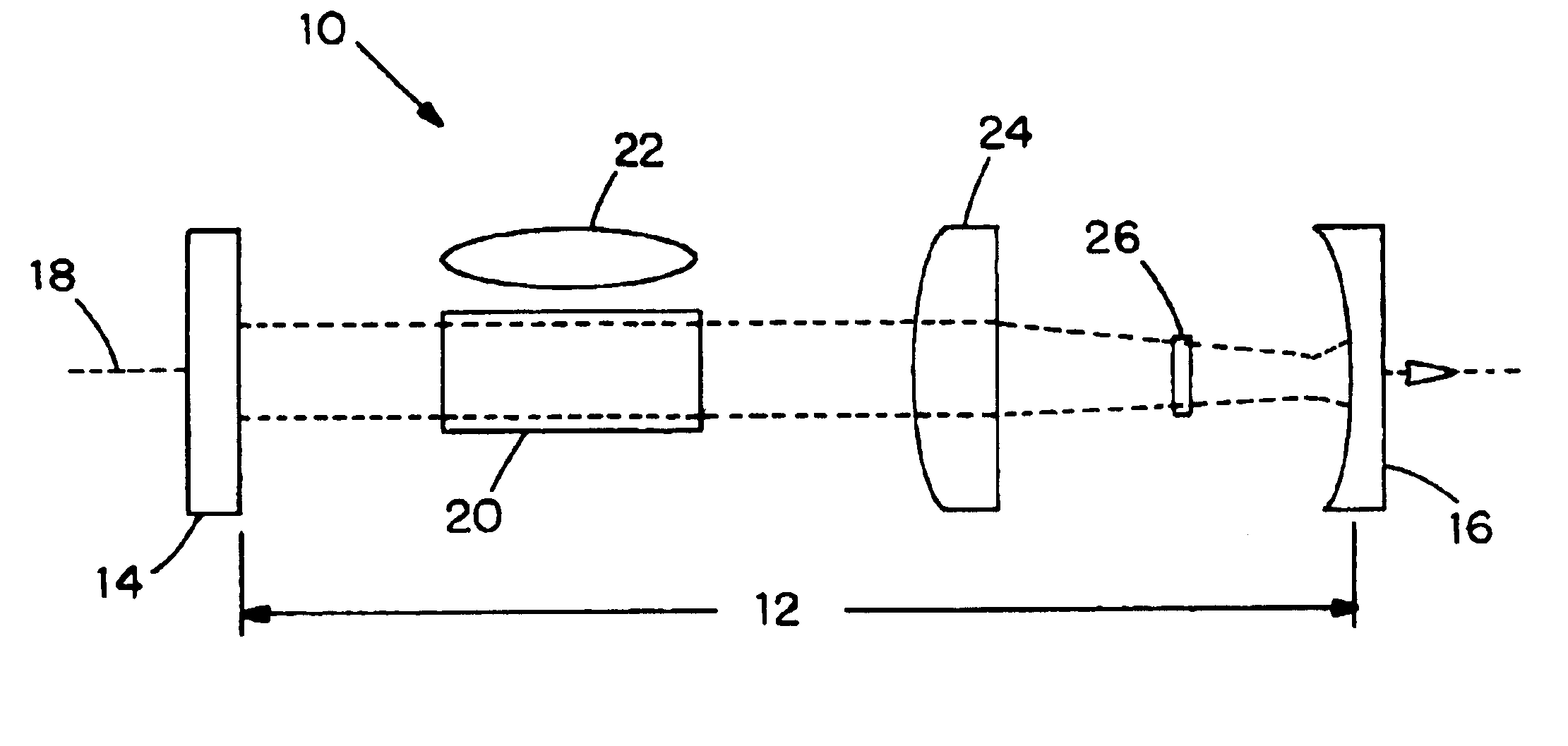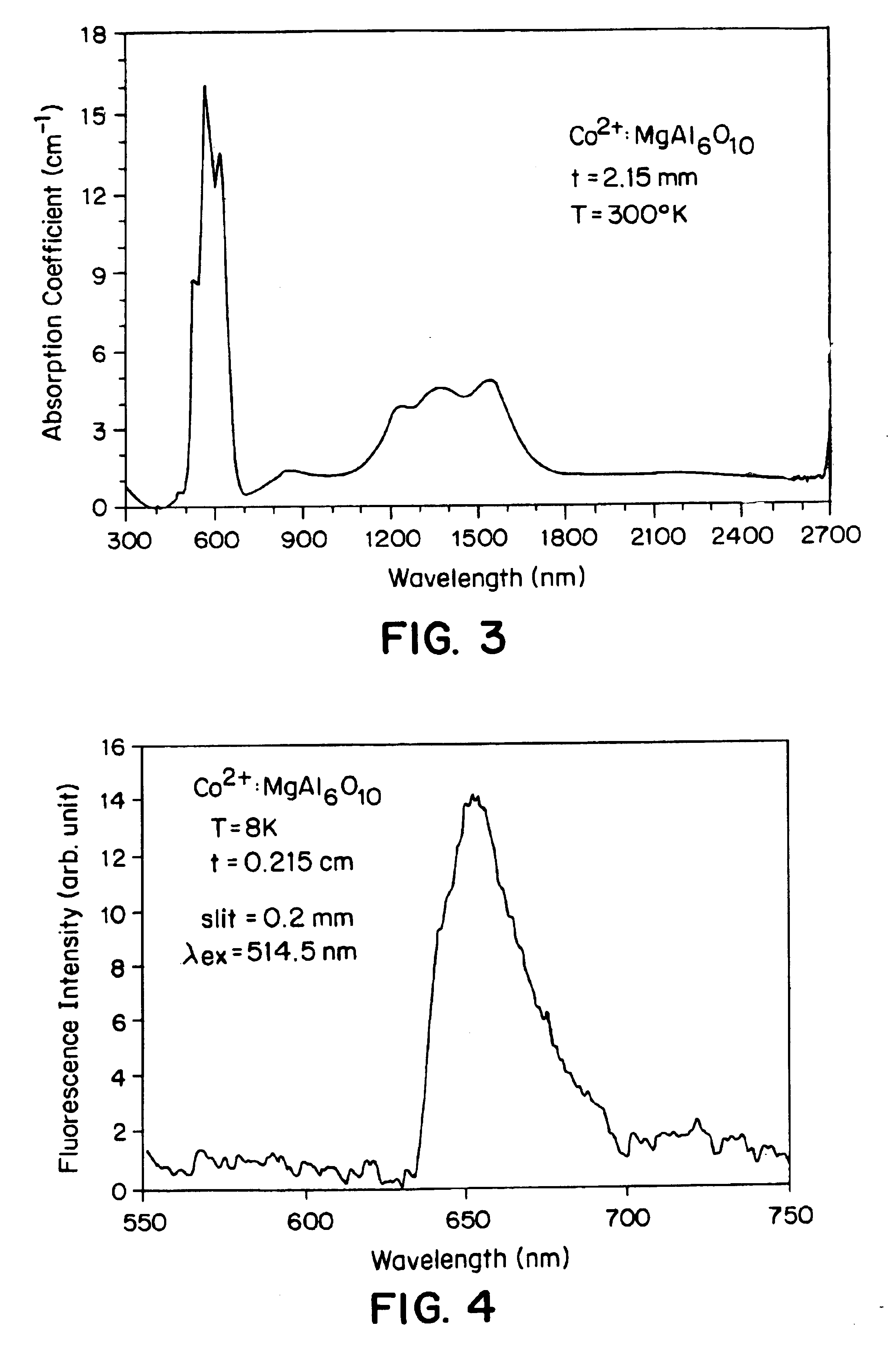Cobalt-doped saturable absorber Q-switches and laser systems
a saturable absorber and cobalt-doped technology, which is applied in the direction of laser details, active medium materials, optical resonator shape and construction, etc., can solve the problems of significantly reducing the efficiency of a q-switch and the power of a laser pulse, and achieves the effect of increasing the efficiency of a saturable absorber q-switch and high aluminum ratio
- Summary
- Abstract
- Description
- Claims
- Application Information
AI Technical Summary
Benefits of technology
Problems solved by technology
Method used
Image
Examples
example 1
General Method for Spinel Growth
The various cobalt doped spinel compositions were grown on 1:1 (MgAl2O4) spinel seed oriented along the <111> axis. Desired compositions were melted in iridium crucibles of sizes appropriate for growth of 30 mm diameter, and 50 mm diameter crystals. The sizes of the melts for larger crystals were circa 3000 gms. The iridium crucibles were inductively heated by 10 kHz RF (radio-frequency) generators. The diameter control was based on controlling the growing crystals weight via controlling the generator output in accordance to the signal from a load cell. On an average, the melting point of the spinel was about 100 degrees higher than the melting point of sapphire. Prior to and during the growth, the melts were maintained under an ambient atmosphere strictly inert. The volatility of the Co oxide dopant was very low. The Co oxide apparently reacted with the spinel components on the heat up, and did not evaporate from the melt. The crystals of 1:1 an...
example 1a
1:3 Spinel Growth
Composition
206.05 gms of MgO0.41 gms of Co3O4 1043.54 gms of Al2O3
The composition was mixed and loaded into 3″ diameter 4-½″ tall iridium crucible of 440 ml volume. The crucible was placed into growth system comprising RF (radio frequency), generator (power) supply, a growth chamber containing the RF coupling coil, zirconium oxide insulation material in an ambient gas enclosure—“Bell Jar,” and an electronic control system. Control was accomplished by controlling the RF generator output in response to the mass of the growing crystal. “ADC” (Automatic Diameter Control) software, supplied by F. Bruni, controlled the shape of growing crystal, temperature increase, and cool down rates, and all other pertinent parameters. The crucible with the oxide mixture was heated to 2150° C. to form a melt. <111> spinel “seed” (small rod-shaped crystal) was immersed (dipped) into the molten mixture. Applying a withdrawal rate of 1 mm / hr along with rotation of the seed at 8 rpm,...
example 1b
1:2 Spinel Growth
Composition
141.56 gms of MgO0.87 gms of Co3O4 1107 gms of Al2O3
The composition was loaded into same crucible as described in Example #1, and placed in an identical growth system. Heat-up time was 6 hours to 2150° C. Rotation rate applied was 8 rpm, pull rate 1 mm / hr under strictly inert atmosphere. Growth time of 150 hours was followed by a 100 hour cool-down period. Grown crystal was harvested at room temperature.
Result: A blue crystalStructure: “Spinel”A0=7.97 A0 Optical Density: 2.4 cm−1
PUM
 Login to View More
Login to View More Abstract
Description
Claims
Application Information
 Login to View More
Login to View More - R&D
- Intellectual Property
- Life Sciences
- Materials
- Tech Scout
- Unparalleled Data Quality
- Higher Quality Content
- 60% Fewer Hallucinations
Browse by: Latest US Patents, China's latest patents, Technical Efficacy Thesaurus, Application Domain, Technology Topic, Popular Technical Reports.
© 2025 PatSnap. All rights reserved.Legal|Privacy policy|Modern Slavery Act Transparency Statement|Sitemap|About US| Contact US: help@patsnap.com



